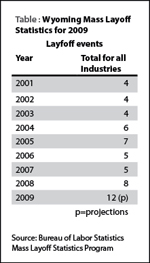Year-end Review of Wyoming’s Labor Market 2009
This article examines the decline in Wyoming’s labor force, as well as the increase in the state’s unemployment rate to its highest point in more than 22 years. It also looks at the increase in mass layoffs and over-the-year job losses.
Early in 2009, Wyoming followed in the footsteps of the rest of the nation and entered the recession according to the Wyoming Economic Analysis Division (Liu, 2009).
In October, the seasonally adjusted unemployment rate reached
7.4% for the first time since September 1987. Seasonal adjustment is a statistical
procedure used to remove the impact of normal regularly recurring events (such
as weather, major holidays, and the opening and closing of schools) from economic
time series in order to obtain a better understanding of  changes in economic
conditions from month to month. The annual average seasonally adjusted unemployment
rate for 2009 is expected to be 5.9%. The labor force — the sum of employed
and unemployed persons — has also decreased from a high of 294,877 in
December 2008 to 292,154 in October 2009. Nationally, the official Bureau of
Labor Statistics (BLS) unemployment rate estimate is referred to as U-3. The
annual average U-5 and U-6 rates, which are alternative measures of labor underutilization,
have also increased over the last year (Cowan, 2009). In 2007 and 2008, the
U-5 and U-6 were 3.4% and 5.7%, respectively, for Wyoming. For fourth quarter
2008 and third quarter 2009, the BLS reported that these rates rose to 6.0%
and 9.5%, respectively, for Wyoming.
changes in economic
conditions from month to month. The annual average seasonally adjusted unemployment
rate for 2009 is expected to be 5.9%. The labor force — the sum of employed
and unemployed persons — has also decreased from a high of 294,877 in
December 2008 to 292,154 in October 2009. Nationally, the official Bureau of
Labor Statistics (BLS) unemployment rate estimate is referred to as U-3. The
annual average U-5 and U-6 rates, which are alternative measures of labor underutilization,
have also increased over the last year (Cowan, 2009). In 2007 and 2008, the
U-5 and U-6 were 3.4% and 5.7%, respectively, for Wyoming. For fourth quarter
2008 and third quarter 2009, the BLS reported that these rates rose to 6.0%
and 9.5%, respectively, for Wyoming.
Since March 2009, Wyoming has also experienced over-the-year job losses. By October 2009, jobs had dropped to 287,200, a 5.5% over-the-year decline from 303,800 jobs in October 2008. This marked the first over-the-year job losses in Wyoming since November 1987. Those over-the-year job losses continued from April 1986 through April 1988 when job numbers finally started to increase again. Job losses are forecast to continue throughout the rest of 2009, and December’s employment is expected to be approximately 279,000.
Mass layoffs have also been increasing in Wyoming (see table) since the  start of the recession. The Research & Planning-BLS Mass Layoff Statistics (MLS) program of the BLS tracks any layoff of 50 people or more by one employer. The number increased from 5 in 2007 to 8 in 2008 and is projected to reach 12 in 2009.
start of the recession. The Research & Planning-BLS Mass Layoff Statistics (MLS) program of the BLS tracks any layoff of 50 people or more by one employer. The number increased from 5 in 2007 to 8 in 2008 and is projected to reach 12 in 2009.
Energy prices dropped dramatically during the recession; the last time this happened was after the Enron collapse in 2001. Wyoming’s unemployment rate increased from around 4% in 2001 to a high of 4.7% in June 2003. After that it slowly decreased and was back down to 3.9% by February 2004. It continued to decrease to as low as 2.7% in October 2007 and January 2008 until this recession. It is not clear when Wyoming’s unemployment rate will return to low levels.
References
Bureau of Labor Statistics. (2009). Local Area Unemployment Statistics, alternative measures of labor underutilization for states, fourth quarter of 2008 through third quarter of 2009 Averages. Retrieved from http://www.bls.gov/lau/stalt.htm
Cowan, Carola. (2009, August). Alternative measures of labor underutilization. Wyoming Labor Force Trends, 46(8)
Liu, Wenlin. (2009, September). Economic Summary: 2Q09. Retrieved November 16, 2009, from http://eadiv.state.wy.us/wef/Economic_Summary2Q09.pdf
